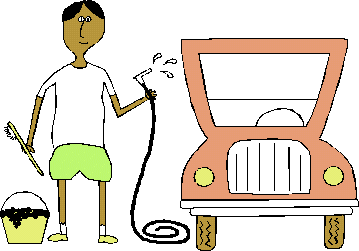

Greetings all,
Welcome to the Spring 2003 edition of our newsletter. Our goal for our
newsletter is two-fold. First of all, we want to keep you informed and entertained with articles relating to Toyota and Lexus
vehicles. Secondly, we want to send out the newsletter on a timely
basis, at least once every quarter. Of course, we will continue sending
out "Lowell's Timely Tidbits", a short version of our newsletter, from
time to time. We want you to have pertinent information relating to your
car as soon as possible; so when we come across news items such as Toyota
factory recalls or press releases, or when we find an article that might be of
interest to our customers, we will send it out.
Once again I would like to thank Clay Drysdale for his part in making this
newsletter possible. We hope you
enjoy this edition.
We would love to get your
comments, so feel free to send us feedback. 
Lowell Nigoff
In this issue:
The Mystery of the "Check Engine" Light
Looking to Buy or Sell a Used Car?
Avoiding a Static Fire at the Gas Pump
How to Wax Your Car
Do You Have a Question?
Advertisements & Self-Promotion
![]()
What does it mean when you see that
little yellow light?
 When you glance down at your instrument panel
on your Toyota and the "check engine"
light is glowing, what do you do? Should you immediately pull off to the
side of the road and call for help, or just keep driving along because nothing
seems to be wrong?
When you glance down at your instrument panel
on your Toyota and the "check engine"
light is glowing, what do you do? Should you immediately pull off to the
side of the road and call for help, or just keep driving along because nothing
seems to be wrong?
Most people have no idea what this alert means, according to a recent story in
the New York Times. The "check engine light" actually means that something may be wrong with the
emissions in your car. All cars built since 1996 have a sensor that will
tell you whether the car's pollution system is failing to operate.
So, the light should really say, "check emissions system." Something
as small as leaving the gas cap off could cause the light to illuminate, but
it's probably not something catastrophic. So, if your "check engine"
light comes on, you probably want to have us check it out. Give us a call
at (859) 233-1173 or email us at lowells@iglou.com
and we'll set you up with an appointment. You don't
need to do it immediately, but it's better to be safe than sorry.
![]()
Looking to Buy or Sell a Used Car?
Are you in the market for a used
Toyota? Maybe you're looking to sell your old car or truck instead of trading it
in (and getting less $$ for it). If you're like most people, you have
probably wondered how much to ask for your car or how much you should expect to
pay for that car you found in the classifieds. One of the easiest ways to
find out is to go to the Kelley Blue Book web site at www.kbb.com.
Here you can select your car's options and get either a "Private
Party Value" (if doing business with another individual), or a
"Trade-In Value" and a "Used Car Retail Value" (if going to
a car dealer). Arming yourself with this information could save you
hundreds or even thousands of dollars. Also, don't forget - the easiest
way to buy or sell a Toyota or Lexus is on our web site at www.chooselowells.com/classified.
Posting an ad on our classifieds page is free to customers of Lowell's.
![]()
Avoiding
a Static Fire
at the Gas Pump
The American Petroleum Institute and the Petroleum Equipment Institute have joined together to remind motorists how to avoid potential problems with static electricity at the gas pump. The groups also are encouraging motorists to follow safe refueling practices with every fill-up.
Static electricity can build up when a motorist re-enters the vehicle during fueling. Here is the way it CAN happen. Sliding across the car seat when you get back into the car builds up a charge that can be released when the motorist returns to the pump and touches the metal nozzle. The tiny spark created from the discharge ignites the highly flammable fuel vapors, causing a flash fire or small sustained fire.
Static electricity-related fires at retail gasoline outlets are extremely unusual, according to API and PEI, but in rare circumstances these incidents have caused a few injuries and property damage. In the rare event you do experience a fire when refueling, leave the nozzle in the fill pipe of your vehicle and back away. Leaving the pump nozzle in the vehicle will prevent a fire from becoming much more dangerous.
The primary way consumers can avoid static electricity problems at the gas pump is to stay outside the vehicle while refueling. It may be a temptation to get back in the car when itís cold, or for any number of reasons. But the average fill-up takes only two minutes, and staying outside the vehicle will greatly minimize the likelihood of any build-up of static electricity that could be discharged at the nozzle.
Motorists who cannot avoid getting back into the vehicle during refueling should discharge any static away from the fill point before going back to the pump nozzle. Static may safely be discharged by touching a metal part of the vehicle, such as the door, with your bare hand.
![]()
The Art of Keeping a Happy Toyota
Take a look outside
- I don't see any snow and ice, and daylight savings time is here once
again. That can mean
only one thing - spring is here!! We KNOW that youíre probably
deep into spring cleaning your house right now, but donít forget about your
car. Few people know this, but we here at
Lowell's are going to let you in on a little secret - April is National Car Care
Month. That means right now is the perfect time to
wash your beloved Toyota, removing the road grime and salt from the winter and putting on a
fresh coat of wax. Waxing
your car a few times a year keeps the exterior nice and shiny and will help
maintain its resale value. The best
way to tell that itís time to wax is when the finish looks dull and water no
longer beads on the surface. 
Before you start, wash and dry your car well.
Itís better to do this by hand, rather than going through an automatic
car wash. Then divide the car into
five sections Ė hood, roof, trunk, right side, and left side.
You want to apply and remove a coat of wax one section at a time to avoid
over-drying. Work on the hood,
roof, and trunk first (to minimize the chance of scratching the surface with
grit from the side panels). Use a
clean, dry, terry cloth folded over.
Make sure to apply the wax by pressing gently and moving your hand in
small, overlapping, circular motions.
Allow the wax to dry for 5-10 minutes.
When the wax is dry (it will have turned a slightly different color when
dry), take another clean, dry terry cloth and use the same circular motions to
remove the coat of wax. Follow this procedure for each section of the car in
succession.
If you have LOTS of energy left over after spring cleaning,
you can apply a second coat of wax to your car, using the same steps.
One coat, however, will probably suffice for most cars.
If you STILL have energy to burn, you may want to buff the finish with
yet another terry cloth, using those same circular motions you no doubt know so
well by now. Buffing ensures that
all the wax residue has been removed, and that the surface is as shiny as
possible, smooth and slick to the touch.
By now, your carís finish will be ready for both the spring showers and the summer sun!
![]()
Do You Have a Question About Car Maintenance That You Want
Answered?
We love to hear from all our good friends and customers
who enjoy reading "Lowellís Toyota Times".
If you have a question about anything related to your Toyota or Lexus,
feel free to give us a call at (859) 233-1173, or drop us a line at lowells@iglou.com.
![]()
Thanks
to everyone who voted for us in "ACE" Magazine's
"The Real Best of Lexington" Poll.
Lowell's was once again voted "Best Mechanic".
Awards &
Honors
Better Business Bureau Integrity Award in 1991.
Voted "Best in the Bluegrass" in ACE magazine poll in 1997, 1999, 2001,
and 2002.
Featured on a television special for employing women in a traditionally male
environment.
Featured on Hometown Heroes for work done in the community.
Be sure to check out our "MONTHLY SPECIAL" at www.chooselowells.com.
______________________________________________________________________________________________
"Lowell's Toyota Times" is published by Lowell's Bluegrass
Automotive. Started in 1979, Lowell's is the the only independent repair
shop in the Bluegrass specializing in the maintenance and repair of Toyota and
Lexus vehicles.
To have your name removed from our mailing list, simply reply and type "remove" in the subject line.